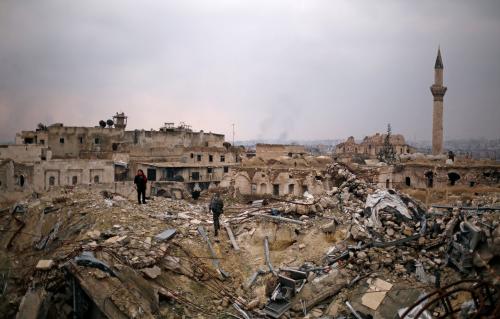The Israel-Gaza crisis serves as a reminder of the threat violent conflicts pose to U.S. objectives, even when they fall outside great power contexts. As the United States seeks to pivot toward a foreign policy focused on great power competition, it needs a strategy for stemming the tide of such conflicts. A conflict prevention approach provides the best path for mitigating that threat while preserving U.S. resources and space for other U.S. strategic objectives. Research has shown that conflict prevention works and is cost-effective. In light of the current conflict trends and U.S. ambitions to proactively shape the emerging world order, it is also necessary.
Conflict prevention in a “new era” of U.S. foreign policy
The number, scale, and complexity of violent conflicts are increasing globally. Most active conflicts are not occurring in countries that rank among the top U.S. foreign policy priorities, but the destabilizing effect of these conflicts and their tendency to compound directly undermine U.S. objectives. Further, growing major power rivalry increases the risk that competitors will exploit conflict-affected countries as a means to expand their geopolitical reach, at the same time making conflicts harder to resolve.
National Security Advisor Jake Sullivan and Secretary of State Antony Blinken have both recently articulated a U.S. foreign policy approach for a “new era.” In his article in Foreign Affairs, Sullivan stressed the need to limit U.S. military entanglements globally in order to focus on great-power conflict and limit vulnerabilities. But reducing U.S. military engagement does not necessarily mean disengaging from non-great-power conflicts, the vast majority of which require U.S. diplomatic attention, not military involvement.
Absent in Sullivan’s article was a commitment by U.S. leadership to prevent the escalation of violent conflict outside of great-power contexts. The importance of this omission was underscored by the fact that Sullivan had to revise the article following the October 7 Hamas attack in Israel to acknowledge that the Middle East is now at risk of significant regional escalation. If the United States is to achieve its objectives of proactively shaping a more free, open, prosperous, and secure world, it needs to recommit to conflict prevention.
The Global Fragility Act and implementing conflict prevention
A rigorous conflict prevention approach must include structural changes to the U.S. bureaucracy to enable the United States to better identify early warning signals and — more importantly — act quickly and decisively in response. It must also include targeted efforts in countries where the risk of violent conflict is significant, where such conflict poses the greatest threats to U.S. interests, and where the United States is capable of impact.
In late 2019, the U.S. Congress took an important step toward prioritizing conflict prevention with the passage of the Global Fragility Act (GFA), which called for a more proactive, whole-of-government approach to conflict and authorized dedicated funds for that purpose. The Biden administration’s strategy formed in response to the GFA was equally ambitious. It committed to converting the U.S. bureaucracy to enable it to work more closely with partners to anticipate and prevent conflict with dedicated personnel and resources; to better coordinate diplomatic, defense, and development tools; and to play the long game through the development of 10-year country strategies.
The GFA is not currently on track to meaningfully strengthen the United States’ ability to prevent conflict and realize the ambitious goals in the legislation or the administration’s strategy, however. Thus far, the GFA’s rollout has been limited to a handful of pilot countries — some of which the GFA’s original sponsors felt were not appropriate. While the GFA can have a positive impact in controversial choices like Libya, pilot countries were selected largely by bureaucratic considerations based on the existing U.S. posture, rather than an objective assessment of the risk escalation poses to the United States and the potential for U.S. impact.
Further, a lack of policymaker buy-in, limited integration of diplomatic and defense tools, and a mismatch between objectives and resources undermine the GFA’s ability to shape the trajectory of conflict in the pilot countries (as described below). Finally, there is not a clear plan for expanding the GFA’s impact to other countries or making structural changes across the U.S. bureaucracy.
The GFA remains an important initiative and vehicle for implementing a comprehensive conflict prevention approach. However, realizing this potential will require new momentum and reforms that address the early lessons from the GFA’s implementation.
Lesson 1: Dedicate greater attention to policymaker buy-in
Conflict prevention is inherently political, requiring tough policy decisions to change the status quo both within U.S. government operations and in target countries. To be effective, policymakers must prioritize conflict prevention in targeted countries above other proximate policy goals that are not always consistent with preventing the escalation of violent conflict — such as great power competition, counterterrorism, or trade. These are things only the most senior White House and State Department officials can do. The GFA has demonstrated the difficulty of attracting and maintaining policymaker buy-in. In Washington, only a few offices are focused on the GFA, and none of those offices have authority over policymaking or policy implementation in the pilot countries.
Lesson 2: Get serious about using diplomacy & defense tools
There is a dangerous tendency to rely solely on foreign assistance to support conflict prevention. When faced with diplomacy’s intangible nature and the Department of Defense’s (DOD) complex bureaucracy, it is much easier to focus on foreign aid that is neatly organized into discrete, measurable programs and directly controlled by Congress’ purse strings. This is one reason why similar U.S. initiatives, like the Stabilization Assistance Review and the Strategic Prevention Project, have focused exclusively on foreign assistance despite explicitly acknowledging that it cannot shape the trajectory of conflict in isolation. The GFA secretariat is trying to leverage the monitoring and evaluation process to think more critically about how diplomacy and defense tools are advancing their conflict prevention goals but need stronger support from Washington policymakers to be effective.
Effectively leveraging diplomacy for conflict prevention will require engagement from the senior U.S. officials who wield the most diplomatic influence, in coordination with diplomats overseas. While many ambassadors in the pilot countries are strongly supportive, progress on things like the Libyan peace process requires significant Washington-level engagement.
Preventative diplomacy should be rooted in more detailed plans that articulate how diplomacy will help achieve U.S. objectives and enable rigorous assessment of what is and is not working. Such plans should connect specific diplomatic actions (for example: requests from the secretary of state, relationships fostered by mid-level diplomats, pressure from public statements, action via the U.N. Security Council or other multilateral bodies) to desired short/mid-term outcomes (cooperation with a political process, a compromise with opposition groups, security sector reform) that ultimately lead to identified goals. The GFA has highlighted the fact that such rigorous plans and the ability to assess the effectiveness of diplomatic tools are too often missing.
Integrating defense tools in the GFA, namely security cooperation and engagement with host-country military officials, has been relatively slow. The body responsible for GFA implementation within DOD has no oversight over security cooperation or the senior military officials at embassies that lead such engagements. Explicit direction from the secretary of defense is likely needed to ensure that these tools are better integrated.
Lesson 3: Set realistic goals and provide the resources to match them
Embassy teams in the GFA pilot countries were tasked with setting ambitious conflict prevention goals, but it is not clear if these goals are achievable given the level of resources currently allotted, including senior diplomatic engagement, staffing, and foreign assistance. This reflects a weakness in some U.S. government planning processes to identify ideal ends, rather than realistic goals. Looking only at financial resources: Congress authorized $200 million annually for a dedicated fund for GFA implementation to complement existing resources in the pilot countries. In 2022, they appropriated only $125 million, equating to only $10-$15 million per GFA country. Those funds are primarily for programs, not operational expenses, and do not include diplomatic funds or dedicated funds for DOD efforts, reinforcing the tendency to see the GFA as only a development assistance effort. Earmarks and other restrictions have also impeded the ability to fully align existing resources with the GFA strategy.
Exploring solutions
Revitalizing the GFA should be a collaborative effort between the Biden administration and Congress, but key elements should include:
- Charge senior officials with authority over policymaking at both the National Security Council and State Department with overseeing the GFA. For example, a USIP Task Force that contributed to the formation of the GFA originally recommended a new deputy national security advisor for strategic prevention.
- Develop a vision for expanding the GFA’s impact beyond the pilot countries. That vision should identify structural changes that need to be made across the bureaucracy in addition to a plan for identifying other high-risk and/or high-impact countries and applying GFA principles and approaches there.
- Get serious about preventative diplomacy, beginning by investing the time to develop detailed, thoughtful diplomatic plans.
- Use annual learning and adaptation processes to think critically about resource allocation. Make sure the people responsible for decisions on foreign assistance allocation, staffing, security posture, and other resources at all relevant agencies are part of those processes. If recommended changes cannot be made, be honest about whether the identified objectives are still achievable.
-
Acknowledgements and disclosures
The views expressed in this article are the author’s own, and not necessarily those of the U.S. government.






Commentary
The US needs to recommit to conflict prevention
What we should learn from the Israel-Gaza crisis and why the Global Fragility Act still matters
December 19, 2023